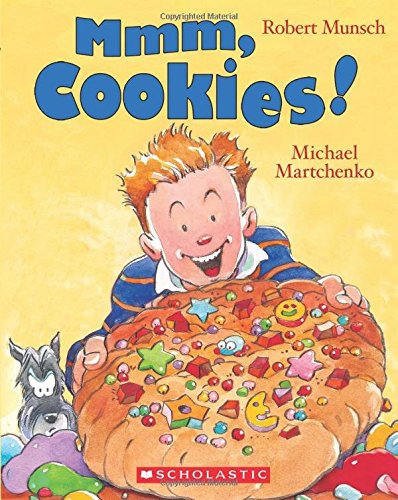This month's Book Nook topic is...
Explaining Why Things Happen with Mmm, Cookies!

In order to truly understand a story, children need to do more than just recognize the words written in the text. Reading comprehension is about understanding the overall meaning of a story, including reading between the lines to understand a story’s overall message.
Discussing why certain things happen in a book is a great way to encourage your child to think about the story and further his understanding. This could mean talking about characters’ emotions or motivations, and talking about “cause and effect”, or how one event leads to another. The better your child understands the stories he hears, the easier it will be for him to read and write stories on his own later.
Let’s get started!
The Book:
Mmm, Cookies! by Robert Munsch
Why we picked it
This hilarious book is about a boy named Christopher who tricks his parents into eating fake cookies made of play clay. Eventually Christopher and his classmates bake a giant real cookie. When Christopher brings the real cookie home, his parents are too afraid to try it!
This story provides lots of opportunities to talk about why the characters do the things they do and what thoughts and emotions might be driving their actions.
Building understanding in the first reading
When you read this story for the first time, it’s best to keep the story moving and have very short conversations that help your child remember the main characters, their actions, and what the main problem is. For example, you could make comments like,
- “This story has a problem – Christopher is tricking people into eating play clay cookies”
- “Christopher’s teacher found a solution – she will show Christopher what it feels like to be tricked into eating a yucky play clay cookie”
Incorporating explanations in later readings
Once your child has grasped the basic story, he’ll be able to think about it in different ways and have longer conversations that deepen his understanding. Being encouraged to explain something also prepares preschool children for the demands of school, where they are frequently asked “Why?”.
You can encourage your child to think about why things happen by using these two strategies:
- Making “thinking-out-loud” comments
- Asking questions that encourage explanations
Making “thinking-out-loud comments”
“Thinking-out-loud” comments show your child how you are thinking about the story and trying to figure out things that are not actually stated in the book. By making these types of comments, you’re modelling a way for your child to express his own thoughts and ideas.
For example, you could say:
- “I’m wondering why Christopher would want to feed his parents pretend cookies?”
- “I’m thinking that Christopher probably realized how mean it was to trick people into eating fake cookies after he got tricked himself!”
- “Christopher probably feels badly for tricking his parents. That’s why he wants to bring home a giant real cookie for them to enjoy.”
Asking questions that encourage explanations
Another way to deepen your child’s understanding of why things happen is to ask questions that go beyond what is written on the page and shown in the illustrations. These questions encourage your child to use his knowledge and reasoning skills. For example:
- “Why do you think Christopher decided to use play clay to make the cookies?”
- “Why do you think Christopher’s teacher decided to play the same trick on Christopher?”
- “Why do you think Christopher’s parents look so scared when he brings them a real cookie?”
If your child has difficulty answering questions like these, you could provide the answer yourself and continue with the book. For example, if you asked why Christopher’s parents look scared when they see the real cookie, you could say, “They think Christopher is going to trick them with a pretend cookie again.”
The more times you read the story, the more you’ll be able to make “thinking-out-loud” comments and ask questions that deepen your child’s understanding of the story. As you engage your child in conversations that encourage him to think more deeply about a book, you’re helping to develop the comprehension skills he’ll need to read successfully on his own.
Happy reading!
More Resources
The strategies in this Book Nook post are drawn from Hanen’s practical, research-based guidebooks for building emergent literacy. Explore the links below to learn more about how these guidebooks can support you.
For Parents I'm Ready! guidebook
I'm Ready! guidebook
For Educators ABC and Beyond guidebook
ABC and Beyond guidebook
